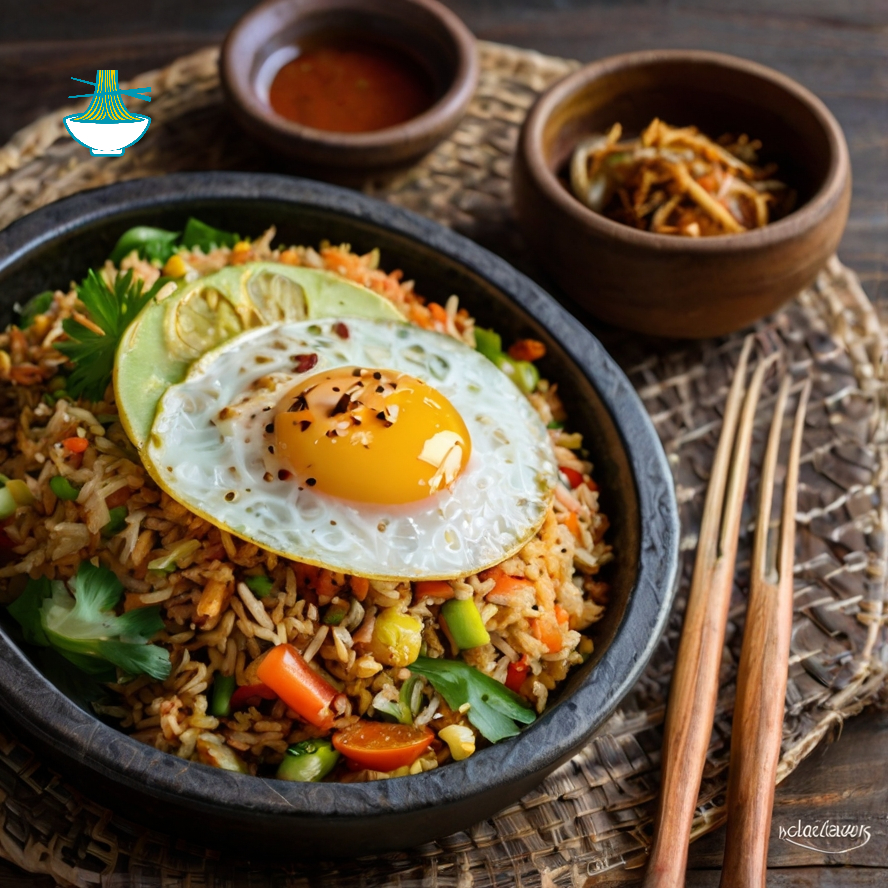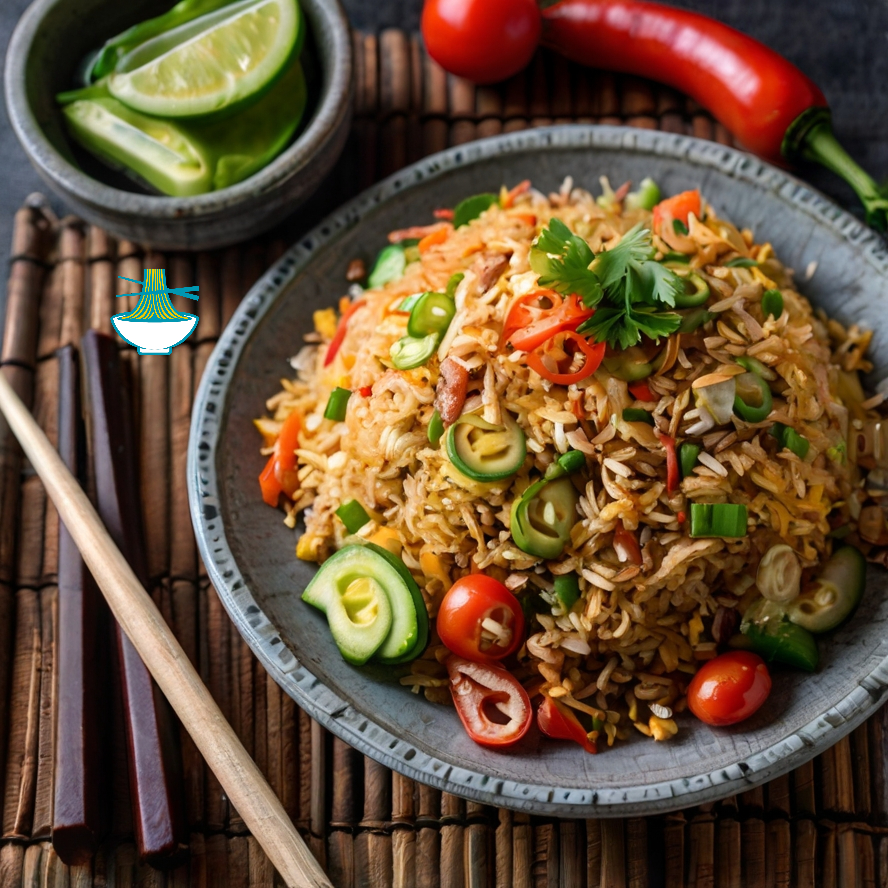Nasi Goreng Malagasy is a flavorful and savory dish that features fried rice combined with a mix of vegetables and sometimes meat, offering a hearty and satisfying meal. The dish provides a great balance of carbohydrates from the rice, vitamins from the vegetables, and protein from the optional meat, making it a well-rounded option for lunch or dinner. The vegetables, such as carrots, peas, and onions, offer essential nutrients like vitamins A and C, while the protein from the meat supports muscle repair and growth. However, depending on the amount of oil and seasonings used, Nasi Goreng Malagasy can be high in calories and sodium. It’s important to moderate the use of salt and oil to keep the dish healthier while still preserving its rich flavors.
Ingredients:
- 2 cups cooked rice (preferably cold, day-old rice works best)
- 1 tablespoon vegetable oil
- 1 onion, chopped
- 2 cloves garlic, minced
- 1/2 cup carrots, diced
- 1/2 cup peas
- 1/2 cup cooked chicken, beef, or shrimp (optional)
- 2 tablespoons soy sauce
- 1 tablespoon tomato paste
- 1 teaspoon ginger, minced
- 1 tablespoon oyster sauce (optional)
- 1 teaspoon turmeric powder
- Salt and pepper to taste
- Fresh cilantro or green onions for garnish (optional)
Alternative Options:
For those who do not prefer meat or follow a vegetarian or vegan diet, there are several great alternatives to consider.
- Tofu: A versatile protein that works well in fried rice dishes. Tofu absorbs the flavors of the spices and sauces, making it an excellent substitute for meat.
- Mushrooms: These can be a perfect replacement for meat, offering a savory umami flavor. Shiitake or button mushrooms work particularly well in Nasi Goreng Malagasy.
- Tempeh: Another plant-based protein option, tempeh provides a nutty flavor and firm texture, making it a satisfying substitute.
Instructions:
- Heat the vegetable oil in a large skillet or wok over medium heat.
- Add the chopped onion and garlic, sautéing until softened and fragrant.
- Stir in the diced carrots and peas, cooking until tender.
- If using, add the cooked chicken, beef, or shrimp, and cook for 2-3 minutes until heated through.
- Add the rice, breaking up any clumps, and stir-fry for a few minutes to combine the ingredients.
- Stir in the soy sauce, tomato paste, oyster sauce, turmeric powder, ginger, salt, and pepper, mixing everything together thoroughly.
- Cook for another 2-3 minutes, allowing the flavors to meld.
- Garnish with fresh cilantro or green onions if desired.
- Serve hot as a complete meal or as a side dish.
Note:
How Nasi Goreng Malagasy Fits into a Balanced Diet: This dish can be a part of a balanced diet, as it contains carbohydrates from rice, protein from the meat or alternatives, and essential vitamins from vegetables. However, it's important to manage certain ingredients for specific diets:
- For a Low-Carb or Keto Diet: Nasi Goreng Malagasy may not fit well into a strict ketogenic diet due to the high carb content from the rice. To make it keto-friendly, try substituting the rice with cauliflower rice or another low-carb alternative.
- For a High-Protein Diet: Adding extra protein like chicken, shrimp, or tofu can make this dish a good choice. You can also use more vegetables and fewer carbs to align it with a high-protein, low-carb approach.
Frequently Asked Questions (FAQs):
1. Can the recipe be modified to be gluten-free? Yes, the recipe can be easily modified to be gluten-free by using gluten-free soy sauce (tamari) instead of regular soy sauce. Additionally, check the oyster sauce for gluten content, or use a gluten-free alternative.
2. What ingredients can be substituted if you have allergies? If you have allergies to specific ingredients, there are some substitutions:
- Soy Allergy: Use coconut aminos or a homemade soy sauce alternative.
- Shellfish Allergy: If you're allergic to oysters or shrimp, simply omit the oyster sauce and shrimp, and use another protein like chicken or tofu.
- Garlic or Onion Allergy: If you cannot tolerate garlic or onions, you can substitute with fennel, shallots, or garlic powder, though the flavor will vary.
3. What is the best way to prepare cold rice for this dish? Using cold, day-old rice is ideal for fried rice dishes like Nasi Goreng Malagasy because it is drier and less sticky, making it easier to stir-fry without clumping. If you don't have leftover rice, you can cook rice ahead of time, spread it on a baking sheet, and refrigerate for about 30 minutes to achieve a similar texture.
4. Can Nasi Goreng Malagasy be prepared in advance? Yes, Nasi Goreng Malagasy can be prepared ahead of time and stored in the refrigerator for up to 3 days. To store it:
- Allow the dish to cool completely before transferring it to an airtight container.
- Reheat thoroughly before serving. It can be reheated in a skillet or microwave, but be sure to stir occasionally to maintain texture.
- While the dish can be prepared in advance, keep in mind that rice dishes are best when fresh for optimal taste and texture.
Nutritional Values and Benefits
Detailed Calorie Information: While the article provided a breakdown of the calories for individual ingredients, it is helpful to include the total calories for a serving of the dish.
- A standard serving of Nasi Goreng Malagasy (using chicken as the protein) contains approximately 450-500 calories, depending on the specific ingredients and amounts used. This makes it a moderate-calorie meal, ideal for lunch or dinner.
- For a more precise evaluation of calorie intake, the total calories can vary based on the use of oil, meat, and sauces. For example, using lean chicken, less oil, and low-sodium soy sauce can reduce the calorie content.
Cooked Rice (2 cups)
- Calories: 400
- Carbohydrates: 90g
- Protein: 8g
- Fat: 0g
- Sodium: 10mg
- Vitamins:
- Vitamin B6: 0.1mg (6% DV)
Nutritional Benefit: Rice provides a solid energy base as a carbohydrate-rich ingredient. It also contains small amounts of vitamin B6, which is vital for metabolism and brain function.
Vegetable Oil (1 tablespoon)
- Calories: 120
- Carbohydrates: 0g
- Protein: 0g
- Fat: 14g
- Sodium: 0mg
- Vitamins:
- Vitamin E: 1.9mg (10% DV)
Nutritional Benefit: Vegetable oil provides unsaturated fats, which are beneficial for heart health. Vitamin E, a potent antioxidant, supports skin health and helps protect cells from oxidative stress.
Onion (1 medium)
- Calories: 45
- Carbohydrates: 11g
- Protein: 1g
- Fat: 0g
- Sodium: 0mg
- Vitamins:
- Vitamin C: 8mg (13% DV)
Nutritional Benefit: Onions are rich in antioxidants and vitamin C, which supports immune function and collagen production, while also having anti-inflammatory properties.
Garlic (2 cloves)
- Calories: 8
- Carbohydrates: 2g
- Protein: 0g
- Fat: 0g
- Sodium: 1mg
- Vitamins:
- Vitamin C: 1mg (2% DV)
Nutritional Benefit: Garlic has numerous health benefits, including heart health promotion, immune system support, and anti-inflammatory properties due to its sulfur compounds.
Carrots (1/2 cup)
- Calories: 25
- Carbohydrates: 6g
- Protein: 1g
- Fat: 0g
- Sodium: 40mg
- Vitamins:
- Vitamin A: 4500 IU (90% DV)
Nutritional Benefit: Carrots are an excellent source of vitamin A in the form of beta-carotene, which supports eye health, immune function, and skin health.
Peas (1/2 cup)
- Calories: 60
- Carbohydrates: 11g
- Protein: 4g
- Fat: 0g
- Sodium: 5mg
- Vitamins:
- Vitamin C: 15mg (25% DV)
Nutritional Benefit: Peas are high in protein and fiber, which promote muscle repair and digestive health. The vitamin C in peas also supports immune function.
Cooked Chicken (100g)
- Calories: 165
- Carbohydrates: 0g
- Protein: 31g
- Fat: 3.6g
- Sodium: 60mg
- Vitamins:
- Vitamin B6: 0.5mg (30% DV)
Nutritional Benefit: Chicken is a great source of lean protein, essential for muscle growth and repair. It also provides B vitamins, particularly B6, which aids in metabolism and red blood cell production.
Soy Sauce (2 tablespoons)
- Calories: 20
- Carbohydrates: 2g
- Protein: 2g
- Fat: 0g
- Sodium: 900mg (39% DV)
Nutritional Benefit: Soy sauce adds flavor to the dish but is high in sodium. It provides protein, but the high sodium content means it should be consumed in moderation to maintain healthy blood pressure levels.
Tomato Paste (1 tablespoon)
- Calories: 15
- Carbohydrates: 3g
- Protein: 1g
- Fat: 0g
- Sodium: 60mg
- Vitamins:
- Vitamin C: 1mg (2% DV)
Nutritional Benefit: Tomato paste is rich in antioxidants like lycopene, which supports heart health and may reduce cancer risk. It also contributes to vitamin C intake, supporting the immune system.
Ginger (1 teaspoon)
- Calories: 5
- Carbohydrates: 1g
- Protein: 0g
- Fat: 0g
- Sodium: 0mg
- Vitamins:
- Vitamin C: 0.5mg (1% DV)
Nutritional Benefit: Ginger is known for its anti-inflammatory properties, helping with digestion, reducing nausea, and boosting metabolism.
Oyster Sauce (1 tablespoon)
- Calories: 9
- Carbohydrates: 2g
- Protein: 1g
- Fat: 0g
- Sodium: 300mg (13% DV)
Nutritional Benefit: Oyster sauce is used to enhance flavor and provide some protein. Like soy sauce, it’s high in sodium, so it should be used sparingly.
Turmeric Powder (1 teaspoon)
- Calories: 8
- Carbohydrates: 1.5g
- Protein: 0g
- Fat: 0g
- Sodium: 0mg
- Vitamins:
- Vitamin C: 0.1mg (1% DV)
Nutritional Benefit: Turmeric is well-known for its powerful anti-inflammatory and antioxidant properties, which support joint health and may improve brain function.
Salt and Pepper (to taste)
- Calories: 0
- Carbohydrates: 0g
- Protein: 0g
- Fat: 0g
- Sodium: Varies (based on amount)
Nutritional Benefit: Salt enhances flavor, but excessive consumption may lead to high blood pressure. Pepper adds flavor with minimal calories and provides small amounts of antioxidants.
Cilantro or Green Onions for Garnish (optional)
- Calories: 1-5
- Carbohydrates: 0.5g
- Protein: 0g
- Fat: 0g
- Sodium: 0mg
- Vitamins:
- Vitamin K: 30mcg (25% DV)
Nutritional Benefit: Fresh cilantro and green onions provide a burst of fresh flavor and are rich in vitamin K, which supports bone health and blood clotting.
Summary
Nasi Goreng Malagasy is a nutrient-packed dish, rich in carbohydrates, protein, and vitamins. It is a well-balanced meal that provides a healthy mix of energy from rice, protein from meat, and vitamins from vegetables. While delicious, it’s important to manage sodium intake from soy sauce, oyster sauce, and salt to maintain a healthy diet.



Comments